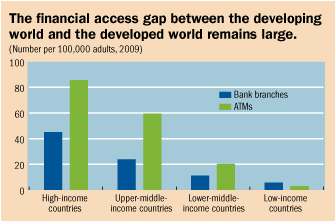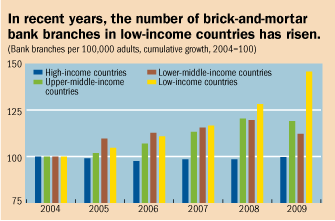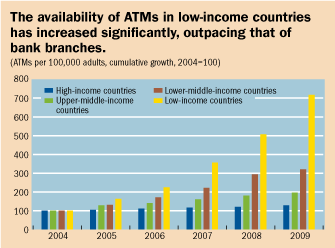Data Spotlight
Branching Out
Finance & Development, March 2011, Vol. 48, No. 1
Atsushi Oshima and James A. Chan
Access to basic financial services in low-income countries is growing
THE vast majority of the adult population in advanced economies has access to basic financial services—deposit accounts via bank branches and automated teller machines (ATMs). In contrast, the availability of such financial services in developing economies (that is, low-income, lower-middle-income, and upper-middle-income countries) is much more limited. This more limited access to financial services impedes economic growth and development. However, over the past five years financial services have been expanding in the developing world.

According to the IMF’s new Financial Access Survey, as of 2009, high-income countries had an average of 85 ATMs and 45 bank branches per 100,000 adults, compared with an average of just 3 ATMs and 6 bank branches per 100,000 adults in low-income countries. Although the gap remains large, the survey shows that access to financial services in developing countries is making strong and steady progress.

In low-income countries, the average number of bank branches per 100,000 adults increased by about 45 percent between 2004 and 2009; over the same period, bank branches in advanced economies experienced minimal growth. Furthermore, the average number of ATMs per 100,000 adults in low-income countries grew sevenfold between 2004 and 2009, whereas in high-income countries the number increased by about 28 percent during this period.

Given the low access levels in developing countries, each new ATM or bank branch has a strong impact. Technological advances have played a big role in these developments. The numbers show that the growth rate of ATMs in low- and middle-income countries outpaced that of brick-and-mortar branches from 2004 to 2009. This trend illustrates the shift in technological changes that allow increased access to financial services at low cost.
About the database
The data are from the IMF’s Financial Access Survey, which was launched June 30, 2010. The survey collects annual data on access to basic consumer financial services for 138 countries from 2004 to 2009, including the number of depositors and borrowers, the volume of outstanding deposits and loans, and other related indicators. The database is available at fas.imf.org and will be updated June 30, 2011, with the results of the 2011 survey.


